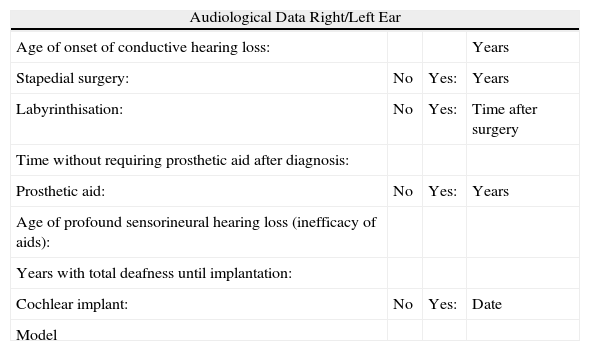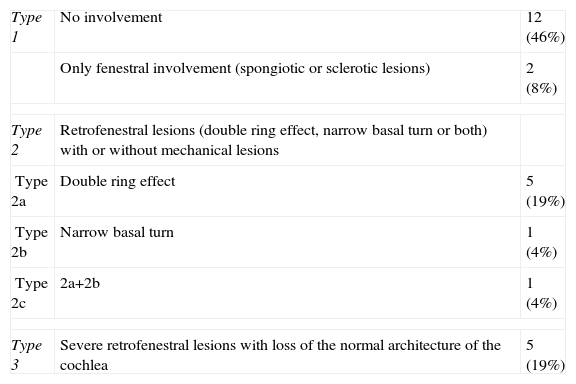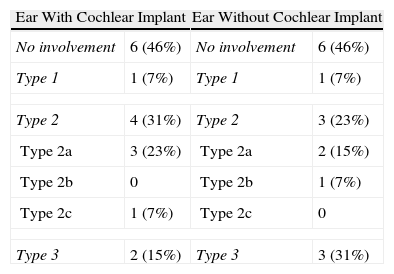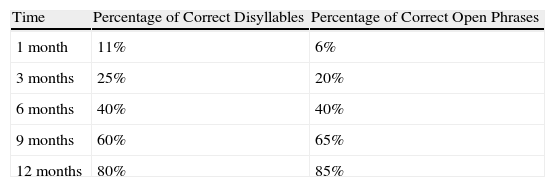Otosclerosis is an osteodystrophy of the labyrinthine capsule producing conductive hearing loss. If the process invades the cochlea, a sensorineural hearing loss usually takes place. The cochlear implant is a good alternative in these patients.
ObjectiveTo ascertain the behaviour of cochlear implantation (CI) in otosclerosis.
Material and methodsWe reviewed a database of 250 patients who underwent CI, performing a retrospective study of 13 patients with clinical, audiological and/or imaging findings of bilateral otosclerosis. The 26 ears were studied as to their natural history, previous surgeries, evolution to profound hearing loss, computed tomography (CT) images, complications and functional results.
ResultsOf the cases studied, 46% were female and 54% were men, with a mean age of 26 years at the onset of conductive hearing loss. Stapes surgery was performed in 19 ears (73%), with a mean patient age of 29 years, and 53% of them underwent CI. CT results showed that there were signs of different degrees of radiological affectation in 54% of the ears. A total of 3 complications took place (23%): implant failure, overstimulation of the facial nerve (FN) and bilateral tinnitus were found. One year after implantation, the average percentages of correct 2-syllable words were 80% and 85% in open sentences.
ConclusionsPatients having profound bilateral sensorineural hearing loss secondary to otosclerosis obtain great benefit from CI.
La otosclerosis es una osteodistrofia de la cápsula laberíntica que produce hipoacusia de conducción. Si el proceso invade la cóclea, aparece una hipoacusia neurosensorial, siendo el implante coclear una buena alternativa en estos pacientes.
ObjetivoConocer el comportamiento de la otosclerosis en la implantación coclear.
Material y métodosSe revisó una base de datos de 250 pacientes intervenidos de implante coclear realizando un estudio retrospectivo sobre 13 pacientes con criterios clínicos, audiológicos y/o de imagen de otosclerosis bilateral. Se estudian los 26 oídos analizando la historia natural, cirugías previas, evolución hacia hipoacusia profunda, hallazgos en imagen mediante tomografía computarizada, complicaciones y resultados funcionales.
ResultadosEl 46% fueron mujeres y el 54% hombres con una edad media de 26 años al inicio de la hipoacusia conductiva. La cirugía del estribo fue llevada a cabo en 19 oídos (73%) a una edad media de 29 años y de estos en el 53% se realizó posteriormente un implante coclear. Los resultados de la tomografía computarizada muestran que en el 54% de los oídos existen signos de afectación radiológica en diferente grado. Se registraron un total de 3 complicaciones (23%): un fallo de implante coclear, una estimulación del nervio facial y un acúfeno bilateral. Al año de la implantación obtenemos un porcentaje promedio de aciertos en bisílabos del 80% y del 85% en frases en contexto abierto.
ConclusionesPacientes que presentan una hipoacusia neurosensorial profunda bilateral secundaria a una otosclerosis se benefician extraordinariamente de la implantación coclear.










